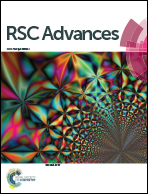Application of three-dimensional flower-like nanomaterials in the fabrication of sandwich-type electrochemical immunosensors
Abstract
A novel and ultrasensitive sandwich-type electrochemical immunosensor was developed for the quantitative detection of carcinoembryonic antigen (CEA) in this work. Three-dimensional (3D) ZnO nanoflowers (NFs) were 3-aminopropyl-functionalized as the matrix to immobilize the primary antibodies (Ab1). The unique 3D flower-like nanostructure of ZnO provided a higher surface area for the capture of proteins. 3D AuPd NFs were employed as the label to immobilize the secondary antibodies (Ab2). The unique 3D flower-like nanostructure of AuPd produced a better electrocatalytic performance towards the reduction of hydrogen peroxide (H2O2). Due to the special electrochemical performance of 3D flower-like nanomaterials, the facile and sensitive fabrication of the designed immunosensor was achieved. Under optimal conditions, the designed immunosensor exhibited a wide linear range from 10−5 ng mL−1 to 102 ng mL−1 with a low detection limit of 3.2 fg mL−1 for CEA. It also displayed an electrochemical performance with good reproducibility, selectivity and stability, which would provide potential applications in the clinical diagnosis of other tumor markers.


 Please wait while we load your content...
Please wait while we load your content...